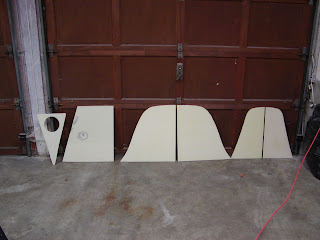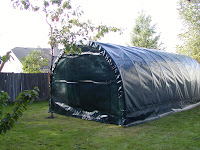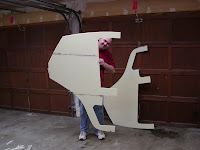I have not spent any time analyzing my laminates to check for fiber\resin ratio, etc. I have learned enough to recognize a "dry" laminate, and I keep an eye out for that. But in general, I just trust that the vacuum bag will work its magic.
Bill Quig's site has a nice page devoted to vacuum bagging. For the most part, I've ended up re-creating his setup. For my first couple of bags I had the bag connected directly to the pump which ran continuously - this got quickly annoying due to the pump noise, and I was mildly concerned about the needless wear-n-tear on the pump. So I bought a vacuum switch and relay from ACP, got an air tank for a reservoir, and life is grand now. I have the switch set to pull ~25", and it kicks back on when the vacuum falls to ~21". My "table" is pretty primitive: just a sheet of melamine, which was helpfully trimmed to 4'x6' by Home Depot for me (because full 4'x8' sheets don't fit in the back of my wife's SUV). I place the melamine sheet on top of of my table saw, with a saw horse under one end for extra support. I've been buying vacuum bag consumables from Fiberlay (they're in Seattle, and it's pretty easy for me to drop by there on my way home from work).

At first, I was anal about waxing the board down with a mold-release, but this process had the negative side-effect of producing some serious static electric shocks. Because of the shocks, and because the laminates\epoxy don't seem to stick to the melamine anyway, I've quit doing the wax step. I've never had a problem getting a laminate to release.
My first few parts I started out by tracing the patterns onto the foam, then bagging them. As noted by other builders, this is bad because usually the ink will diffuse\disperse with the epoxy, and your careful lines are gone when you un-bag the laminate.
I have found that it helps to develop a system when doing vacuum bagging, and follow it every time. That way all of the steps become habit, and you don't think about it much. I have no pretensions to being an expert in this area, but here is my current procedure, perhaps it will help others:
- Get the rough dimensions of the part from the patterns
- Cut out a piece of foam to those dimensions (generally just a rectangular piece). In some cases I've had to glue foam pieces together to get a large enough piece.
- Drill holes in the foam using a cordless drill. (This step does get old, but I'm almost done with my flat parts and don't want to create a tool to do it.)
- Run a RO sander over both sides of the foam, mostly to knock down any bits of foam sticking up from the drilled holes.
- Sweep and blow off any foam bits or sanding dust.
- Cut a piece of bag film to suit the part size, lay down bagging tape around the perimeter, and set it aside.
- Cut a piece of breather material (glorified Christmas tree felt, I swear) and set it aside.
- Cut a piece of perforated release film and set it aside. (On one bag I didn't use this stuff, and had a heck of a time getting the felt off of the peel ply).
- Cut two pieces of peel ply, and set them aside.
- Cut the glass pieces, and set them aside.
- Lay first layer of peel ply on table, then lay the first glass piece on top of that.
- Mix epoxy.
- Wet-out bottom layer of glass & peel ply (Ian says to do peel ply first, then glass, but I do them together). I try to leave this bottom layer a bit "wet", since some of the epoxy will get sucked up through the perforations in the foam.
- Lay foam on top of the glass.
- Lay top layer of glass on top of foam.
- Wet-out top layer of glass.
- Lay peel-ply on top of glass, and squeegee it out (usually there is sufficient excess epoxy in the glass below, to wet-out the peel-ply in this step)
- Lay release film on top of peel-ply.
- Lay breather fabric on top of release film.
- Lay vacuum bag fitting on top of breather film (not directly on top of the part). I kept forgetting this step the first few bags, very annoying to have to pull part of the bag film up to fix.
- Lay the bag film over the part. Get it positioned, and then remove the paper off of the mastic. Press down on all edges, especially the corners.
- Cut a hole over the bag fitting, and attach the top fitting to connect the bag to the pump.
- Turn on pump, wait for it to pump down and shut off, listen\look for leaks & fix if any. Then walk away and leave it alone.
Usually I will leave the bag overnight (I'm not in a huge hurry). On a good bag, the pump only runs about once every 1-2 hours. On a bad bag it will run every 20-30 minutes (and of course I can never find the leak). After unbagging, I strip off all of the consumables, trace out the part pattern, and cut out the part with a jigsaw. Voila, done.
(Side note about cutting glass: as a novice, I've been dismayed to learn how fragile raw fiberglass is. Even careful handling is bound to snag it here or there, and it really does not like being folded. If your fingers & hands are not smooth\soft, the glass can even snag on your skin. To avoid this, I always wear gloves while handling the glass (a good idea anyway, to avoid the itchies). Normal scissors\shears will not cut glass very well (you end up with a lot of "runs"). Instead, the "pizza-wheel" fabric cutter works well, and I've also been using some "composite shears" from ACP composities that have serrated edges to minimize the runs. I'm also considering some electric cutting shears.)
Bill Quig says that he weighs the glass before bagging, and mixes that much, plus another 25% extra resin. Theoretically I like this approach, but don't like the extra handling that the weighing process entails. For now I (think I) have gotten pretty good at intuitively knowing about how much resin I will need. Occasionally I'll run short in the middle of a layup, and need to mix more which is not a big deal. If I end up with less than 4oz wasted epoxy, I'm satisfied.
Here's a picture of my largest bag so far (it barely fit on my board). This was destined to become one of the main cabin rear bulkheads. And here's a picture of some of the finished results:
And here's a picture of some of the finished results:











